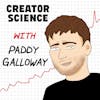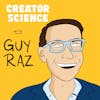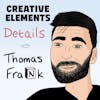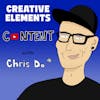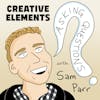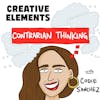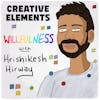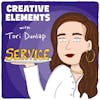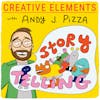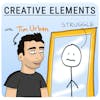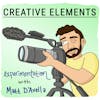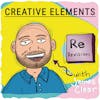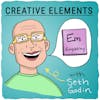
BONUS: How To Build an Audience From Scratch, Understanding Discovery and Relationship Platforms, Email vs Newsletters, Vertical Integration for Creators, and more
Play EpisodeMy guest appearance on the Newsletter Operator Podcast
EPISODE DESCRIPTION
For this week's episode, I was recently on the Newsletter Operator podcast hosted by Matt McGarry and Ryan Carr. Matt was actually a guest on this podcast back in episode 145.
This is one of the most unique and densely packed interviews that I've personally given, so they've graciously allowed me to share that episode with you here today.
We talk about how to build an audience from scratch, understanding discovery in relationship platforms, email versus newsletters, how to build a paid community, vertical integration for creators, and a whole lot more.
Full transcript and show notes
***
CONNECT
📬 Subscribe to Creator Science
🙏 Make a guest or mailbag request
📝 Check out our curated Playlists
***
SPONSORS
💼 View all sponsors and offers
***
SAY THANKS
💜 Leave a review on Apple Podcasts
Learn more about your ad choices. Visit megaphone.fm/adchoices
Jay Clouse [00:00:00]:
Hello, my friend. Welcome back to another episode of creator science. I have some good news and some bad news for you this week, and I'll start with the bad news. This past week, I tested positive for COVID. I was able to hide from the virus for 3 years, but it finally got me and you can probably hear it in my voice. So I'm on bed rest right now, which brings me to the good news. The good news is that I was recently on the newsletter operator podcast hosted by Matt McGarry and Ryan Carr. Matt was actually a guest on this podcast back in episode 145.
Jay Clouse [00:00:32]:
And this is one of the most Unique and densely packed interviews that I've personally given, so they've graciously allowed me to share that episode with you here today. We talk about how to build an audience from scratch, understanding discovery in relationship platforms, email versus newsletters, How to build a paid community, vertical integration for creators, and a whole lot more. So I think you'll really enjoy it, and we'll get to that episode in full right after this.
Matt McGarry [00:00:59]:
Welcome to the newsletter operator podcast. I'm Matt McGarry. And I'm Ryan Carr. And in this podcast, we teach you exactly how to build, grow, and monetize your newsletter.
Ryan Carr [00:01:07]:
We'll talk to the best newsletter operators, creators, and media founders in the space breaking down their strategies and growth tactics.
Matt McGarry [00:01:14]:
Awesome. Let's get into
Jay Clouse [00:01:18]:
it.
Matt McGarry [00:01:26]:
Hey, Jay. Welcome to the podcast.
Jay Clouse [00:01:28]:
I am thrilled to be here, Matt Ryan. Thank you for having me.
Matt McGarry [00:01:31]:
Yeah. Thanks for joining. You're someone who I kind of struggle to describe in 1 or 2 sentences. Like, you have a awesome newsletter. You have a private community of podcast that I really enjoy. You help creators become better creators and grow and monetize their audiences. But what do you call yourself? How do you help people? Give us the introduction kind of.
Jay Clouse [00:01:48]:
I call myself a creator. It's it's awkward to say I'm the creator of creator science. Like, the double word creator is kind of annoying. So when pressed, I'll say I'm the founder of creator science. And if you will say, what is that? I said, media companies supporting professional creators and I'm cross platform. I'm on a lot of platforms because The creators that I serve are on a lot of platforms. And so I want to be as much a practitioner as I am an educator, which puts me in a very challenging position of doing all of the things and trying to do them well and incredibly. But let's just say Jay is the founder of Greater Science.
Matt McGarry [00:02:23]:
Yeah. I like that. Give us an idea of, like, the different platforms you're on and how to use them. So you have a newsletter, podziness, etcetera. Tell us, like, we'll start with your newsletter, for example, because we talk a lot about newsletters, As you know so what's your newsletter called? What what is it about? How many subscribers do you have? And maybe if you can share, like, engagement data too, like, over and click the rate. We always love to hear about that.
Jay Clouse [00:02:42]:
Well, you're not gonna believe this, but the newsletter is called Creator Science. The podcast also called Creator Science. The newsletter is about 41,000 subscribers At this point, I can pull up ConvertKit here. 41,000 subscribers. Open rate is 40%. Click through rate's about two and a half. Click through rate is always something I've had, like, kind of an antagonistic relationship with. That's where the newsletter sits right now.
Jay Clouse [00:03:04]:
The podcast does between 3550000 downloads per month. The YouTube channel literally just crossed 20,000 subscribers moments before I joined this call. And we're getting close to a 1000000 views there all time. So it's it's all over the place, and it's it's all growing pretty well.
Matt McGarry [00:03:22]:
And then break down your business model for us. So you have a couple of different ways you you make money. Tell us what those are. We can we can dig into those.
Jay Clouse [00:03:30]:
I have what I count as 6 different revenue streams. The biggest one is my membership community, The LAB, that accounts for about 70% of my revenue, Followed by my sponsorship part of the business, which I believe is, like, 15? I forget What percentage that is. But it's memberships, sponsorship, affiliates, digital products, Services and royalties.
Matt McGarry [00:03:59]:
That's interesting. So I I want to break down all of those, but maybe a good place to start would be a question from Our audience, because we have a lot of people in both of our audiences who are aspiring creators, aspiring founders. You have a lot of advice for them. I think your stuff is really insightful. It's helped me a ton. And so from Twitter, what is the wisest path to become a full time creator? I think that's a good parallel because, like, there's lots of ways to to make money right away, but Maybe that's not the best path in the long term, so I'm curious to get your take there.
Jay Clouse [00:04:26]:
Yeah. I I put out a tweet about this recently. So I'm going to kinda key off of that because this is a little bit Generalized in terms of, like, platform. I don't wanna be prescriptive in terms of platform. We can we can go into my opinions on, like, where There is the most underpriced attention right now. But I would say if you're trying to start from 0, most important thing is to choose a subject you're curious about. This gets even more powerful if it's a subject that you already have some experience in. If you already have experience in some realm and you wanna continue to double down on that, choose that for sure.
Jay Clouse [00:04:56]:
If you don't have experience in some realm that you wanna double down on or you have experience but you wanna go somewhere new, choose a subject that you're curious or really interested in. Spend a ton of time researching it, consuming everything in and around it. Not even just stuff that's happening today, but, like, past materials that are related to it. Then I would publish summaries of the things that you've learned from that effort of consumption. Like tell people, okay, I've been like Consuming a ton of information about the subject. Here's my summary of the most important interesting bits of it. That can become Probably a newsletter is a good place to be for that. But again, I'm gonna be fairly platform agnostic right now.
Jay Clouse [00:05:35]:
If you're consuming all of this, you're starting to write summaries of what you're learning. At some point, You will start to have a little bit of a voice in your head that starts to make connections between different things that you're learning. And you really need to tune into that. I think a lot of people tune it out for too long. They have, like, imposter syndrome and they don't trust themselves to make their own connections and assertions and opinions. But you are absorbing so much information that you're in a great position to start connecting dots, and you should trust yourself to do that. When you connect those dots and form these original opinions, then you should start to publish those opinions instead of just publishing summaries and curations and aggregations of what you're learning. Now, you are Getting more editorial and you're sharing your insight, your opinions.
Jay Clouse [00:06:19]:
And if you're if you're doing that consistently, then the game is just getting better and better at the craft of Whatever medium or platform that you're on, and then do that for, like, 3 years, and you're good.
Ryan Carr [00:06:30]:
If you were getting started today and you wanted to grow the fastest, What what kind of platform would you look for?
Jay Clouse [00:06:36]:
It depends on your interest in video because there are kinda 2 paths. There's the video first path and then there's the writing first path. It's rare that somebody is great or interested in being great at both and can do both concurrently. So you kind of have to pick 1 or the other. If you're going the video route, then I would be focusing on Instagram reels and YouTube shorts right now. I think TikTok is also still performing really, really well, but I think it's a different audience and a different game. And personally, I think it would be more difficult to monetize and build a business off of a TikTok audience. If you are Drawn to writing, then I would be going LinkedIn right now.
Jay Clouse [00:07:19]:
I think LinkedIn is trouncing Twitter. I think Twitter is dying a slow death, unfortunately. Hopefully, it pulls out of this nose dive. But, if you don't already have an engaged audience on Twitter, it's a tough place to be right now, I think. And those are discovery platforms. So I think it's always gonna be easier to get attention on what I classify as discovery platforms, where there is an innate Mechanism for connecting new viewers to your work. Newsletters are interesting spot in this moment where there's actually Some organic discoverability in newsletters now too. So it's creeping into, like, this in between place where, yeah, newsletters Have more discoverability and growth potential organically than they ever have.
Jay Clouse [00:08:01]:
And so that's that's interesting. I think email should be part of every single creator's Strategy. And I say email, not a newsletter because I see a little bit of difference between those 2 classifications. And I think Email is a core part of everyone's strategy whether you want to write a newsletter or not.
Matt McGarry [00:08:19]:
Really quickly break down the difference between a Discovery platform and a relationship platform. I think it's those are the terms that you use. Explain that for us.
Jay Clouse [00:08:26]:
Yeah. Discovery platforms have this built in Mechanism for organic discovery of your content. Typically, as an algorithm, it's some platform that is probably monetized through ads. And so that platform is incentivized to connect Great content to people who are consuming content because that keeps people on the platform. That's more time on platform to sell ads to. Right? So social media, YouTube, Google, These are monetized by ads. You are the product, but as a gift, they bring attention to your Content in that way. That's a discovery platform.
Jay Clouse [00:08:59]:
There's a third party that's incentivized to connect people to your content. A relationship platform is decentralized. There is not a third party that is incentivized to drive people towards your content. This is email, podcasting, SMS, and I would even I would even put Private communities in this bucket. However, the upside of this is there's also no third party that can change the rules. You are building distribution that you own An email, podcasting, SMS, or private communities. And that's really, really valuable. So the game, in my opinion, is Leveraging discovery platforms to bring in new attention to you and your work and then kinda siphoning that off into a relationship platform where you build a means of distribution that you own for the long term.
Matt McGarry [00:09:41]:
Let's talk about relationship platforms because I think it's something you talk a lot about. I almost exclusively talk about, And you bring up, like, the 4 different types, which I think a lot of people don't even realize that. They think about email or newsletters is the only one. We have a lot of audience who has Twitter following or LinkedIn or whatever, but they don't have any relationship platforms. Where should they start there? Like, what do you think how do you think about the pros and cons of all those Four different, relationship platforms, what should people use first?
Jay Clouse [00:10:07]:
I I think email is the move. I think you can make a compelling case for SMS If you really wanna do it and you typically communicate in short frequent bursts, you know, SMS is almost as if You have a decentralized private Twitter feed or could be, you know. But I think email should be part of every creator's Stack, because that is still where you have probably the the easiest path from awareness to purchase behavior. It's it's just what the back of so many creator businesses are built on. And, you know, it's it's a great alignment of incentives. The people who receive your email are consenting to receive it, and it will reliably show up in their inbox and maybe their primary tab For as long as they would like it to. There isn't a feed that is choosing the most relevant emails for you. It's still chronological.
Jay Clouse [00:11:01]:
There is the tab thing in Gmail. So there is a little bit of that, but at least emails are showing up chronologically in the inbox. And if I want to hear from you and I decide at some point I want to hear from Matt. And I drag it over my primary tab. It's gonna keep going there until I stop opening it or stop pointing it.
Matt McGarry [00:11:20]:
And then since we're on that topic, emails versus newsletters, how do you think about that? A lot of people don't wanna write a weekly newsletter. That's a lot of commitment. Right? How should they think about the alternatives that especially if they're doing this part
Jay Clouse [00:11:30]:
It's a square rectangle situation. All newsletters are email, not all emails are newsletter. And I I think that there are lots of things that I would want to communicate via email that don't fall in the bucket of being classified as a newsletter. Today, I had 2 open spots sorry, 3 open spots in the lab, and I wanted to let members who are on the basic membership, The entry tier to the community. I wanna let them know that, hey, there are 3 spots available for people who want to upgrade. It's not a newsletter. I didn't wanna send a newsletter. I just wanted to send Communication to the small number of people via email, you know.
Jay Clouse [00:12:09]:
And so that's a really important style of communication For me is communicating with different segments of my audience about different things and not having it be like a digital version of a Postcard or a newsletter or something. It's it's or a newspaper or something. It's it's much more like I just have something to tell you. And this is my most direct, Consistent way of communicating with you. Right now, I'm rebuilding my personal website because I want to have a personal blog. And I started building it on Ghost. And I thought to myself, this is the time when I'm just gonna go all in on Ghost, actually. I'm just gonna use Ghost emailing functionality.
Jay Clouse [00:12:49]:
Everything I write will just send directly via Ghost. But But as I'm getting it built, I'm realizing, gosh, but when people sign up, I want to send them a welcome email. I wanna I wanna have a great experience post sign up that is controlled, and a lot of newsletter platforms don't really allow for that. I need an email marketing platform. So that's the way I think about the differences.
Matt McGarry [00:13:11]:
Yeah. You don't wanna lock yourself into where you can only send someone a newsletter once a week or once a day, and you can't send them anything outside of that. And if it doesn't have this Design a template like they're not gonna receive it. There might be a little bit of a false dichotomy. Some some people's mindsets were like, they feel like they have weekly newsletter, and they're afraid to send that side of that. I think people need to kind of break through that and say it's okay to send the occasional marketing email
Jay Clouse [00:13:31]:
or an
Matt McGarry [00:13:31]:
update or the stuff outside of that. It's not really gonna affect you in a negative way.
Jay Clouse [00:13:34]:
I think the term newsletter is something that is perpetuated by platforms. This is this is a hot take. I'm thinking this for the 1st time and articulating it in real time. But I think the term newsletter is perpetuated by email marketing platforms who want a foothold. And so this is a known Modality of sending and receiving email. And so they say we're a newsletter platform because that's what get customer gets customers in the door. But just about every creator I've ever met who has started sending a newsletter has felt limited if they do not have email marketing capabilities within that tool. And so really, anything you want to send emails through, you want email marketing capabilities.
Jay Clouse [00:14:15]:
Yeah. I think any newsletter platform will add to its stack, a feature set of just pure email marketing. It's just not how it's marketed. And so a lot of people who are becoming aware of newsletters and opting into them for the 1st time or starting to use them for the 1st time, they have an incomplete view of what the function of email looks like for a creator.
Ryan Carr [00:14:33]:
Yeah. I mean, we found similar things at the hustle. And, I mean, across all the newsletters that we work with, Kind of one off marketing sense tend to convert significantly better to to, you know, your kind of paid products or your revenue generators than just plugging in the newsletter. So yeah. I mean, totally experience totally aligns there.
Jay Clouse [00:14:51]:
Just a quick break for our sponsors, and we'll be right back to the show. And now back to the show.
Ryan Carr [00:14:58]:
You mentioned the lab. Could you and, you know, your community, like, could you explain a little bit more about about the lab and how you've built it Kind of what the feature set is there?
Jay Clouse [00:15:07]:
Yeah. The Lab is my private membership community for professional creators, people who are Doing this or working towards doing this as a full time means of income and and their lifestyle. So the the point of the lab at this point is for these people who are well beyond the basics, who are operating practitioners, running real businesses, Is the landscape of being a creator changes constantly. And you don't want to wait for Some new piece of thought where from someone else to react or innovate. Professional creators are innovating all the time. They're experimenting. They're trying things out. They're learning from it and they're operating based off of it.
Jay Clouse [00:15:47]:
So I want to create a space where people could ask questions of other people who are in that same trench and a place for people to share The experiments and the results of those experiments that they're running in real time. Like I said, it's become the most significant part of my of my revenue. I've made a bunch of Different design choices in the lab. Like, we have a 200 member cap for the community spaces there. So it's It's been, like, the financial engine that's allowed me to experiment and try a lot of things in my business, invest in growth. The the YouTube channel that I mentioned, that's a new effort over the last 16, 18 months, and that has been funded primarily by revenue that's coming from the membership. So I think that similar as I think every creator should use email. I think every creator should have some means of revenue that is a direct relationship and transaction between them and their audience because that's a little bit more resilient.
Jay Clouse [00:16:42]:
You know, I see a lot of creators get into this and I think the strategy of monetization, really, the only way towards monetization is through Sponsorship, ad revenue, brand deals. That's a great source of revenue. That's really, really great. But it's also less in your control. And a lot of times when that goes away. It's not even anything to do with you. It's like macroeconomic type things. And typically, if you have a direct relationship with your audience and something that they can purchase directly from you without a third party being involved that helps you build a more resilient business.
Matt McGarry [00:17:13]:
For a sense of scale, so 200 members, is a high price thing. I think the starting price is at $2,000. So, like, give us a sense of, like, what type of revenue is generated so the audience has an idea of how successful these things can be.
Jay Clouse [00:17:24]:
It's annual only. So, you know, the best figure I can give you is ARR, the annual recurring revenue, which is about $324,000. It's it's the equivalent about 27,000 monthly recurring, but it it recurs annually, you know. I didn't do big launches of it, So it's actually a pretty even distribution of what months members joined in the previous year, Which was intentional. So this year, it it almost feels like MRR on a monthly basis because I get a lot of renewals. But it's it's a larger price point on each of those those renewals. And I thought that was important because, One, it was really important to me that I designed the membership so that was sustainable from the beginning. And I was incentivized to invest a lot of time in it because the experience is a lot of access to me and a lot of My time and attention in there.
Jay Clouse [00:18:16]:
And 2, a lot of the value is derived from the questions, the ideas, the Experiments the conversations between members. And so in a community like that, I think it's really, really important to limit the volatility in the literal membership. You don't want people coming in and going out because the relationship is the value that I find in this space. And so I'm not going to invest A lot of time or effort into relationships that feel very, very temporary because people are coming in every month or 2 or 3. Instead, I wanted everybody to give it a full year of effort upfront. And so that's a commitment on the point of the member. I recognize that. That's also like the type of person that I wanted to filter for, To be honest, you know, I think every design design decision you make and how you build a product, whether it's a membership or not, Is, a decision that filters for the eventual customer.
Jay Clouse [00:19:09]:
Like design decisions are customer decisions. And I wanted a committed professional person.
Matt McGarry [00:19:18]:
So we talked about creators monetizing things outside of ads and sponsorships. You started with a community. I wanna talk about different revenue models outside of just community, but let's start with that one since we're on this. How do you start a paid community from scratch? Because there's kind of a cold start problem. If you're, like, trying to sell a community and no one's in it, you can't really sell it because that's the value, or maybe you can't. So how do how do you think about starting 1 from from the beginning?
Jay Clouse [00:19:39]:
This is theoretically true, but I think the bar is much lower than most people think. And let me also just preface it by saying, I do not paint a rosy picture of Community building or membership building. It's a hard thing to do. But I want to follow it up by saying I think a lot of people think it's going to be harder to get Started than it actually is. In my opinion, you need 5 people. 10 people would be great. But in my opinion, you need 5 people. That's not a big that's not a big number, You know, now it's important, whatever number you get between 510, you want them to all show up at basically the same time.
Jay Clouse [00:20:15]:
Because then you have a core group that starts to coalesce. You can start to run live sessions. The smaller your membership, the more I think you should lean on live sessions to Very hand to hand, create connections between people, and that'll start to spawn conversations in the forum, direct messages. The the more I know and relate and like the people in here, the more I'm going to be willing to put myself out there asynchronously in a forum. So it's it's important to introduce people to each other early on. I have a I have a 2 phase approach to launching a membership. And this is And of course, I made called Build A Beloved membership. But the 2 phase approach that I share is a private opening and then a public launch.
Jay Clouse [00:21:00]:
So during the private opening phase, that is saying, okay, I'm gonna start this community. It's gonna be priced to x. But I want to give my biggest fans, my closest supporters, 1st opportunity to join this. And I want them to help build the cultural cultural fabric of the community. So when I launched the lab, I priced the membership originally at 9.99, $1,000 per year. And I went to my email list, my social media, And I said, hey, I'm starting a membership. It's for professional creators. I don't have a sales page.
Jay Clouse [00:21:28]:
I don't have anything to show you. But if you trust me, sight unseen, you can join for 50% off your membership for the life of that And I didn't have to create anything other than the digital space in the back end. And I had somewhere between 12 20 people that joined at that point, which is a really, really great start. You have a small group. You can build connections. You can also document what the community experience is like. So instead of creating a sales page That is all theoretical. Like, we will have this, we will have this, we will do that.
Jay Clouse [00:21:57]:
The moment you go out with a sales page, you are actually sharing Real quotes from members. You're sharing photos from the live sessions you're doing. You're showing screenshots of the community and some of the activity in there. You're documenting a party that's already in progress. The cold start problem is I'm inviting people to a party, but no one's at the party yet. And so this private opening public launch is a good way to get some people at the party. So when you go out to the rest of the world, people who are going to be more on the fence by default, it's a more compelling pitch.
Matt McGarry [00:22:28]:
I love that. One question about the live sessions. How do you think about those? Like, are they masterminds? Is it do you have a speaker come in? Any examples you can pull that would be be helpful for people who wanna Just some live community session.
Jay Clouse [00:22:39]:
There are a lot of different types of live sessions you can do. And I think you have to ask yourself, what is the role of programming? I call live sessions programming. What is the role of programming in my membership? Is it knowledge transfer? Is it connection between members? Is it access to people that they typically wouldn't have access to? You need to ask yourself, why do I wanna have programming? What's the point of it? And there are Types of sessions you can do within that. If it's knowledge transfer, you know, you might wanna do like an office hour session. You might wanna do a masterclass. If it's connection between members, you might wanna do some sort of social or, you know, some sort of almost community speed dating. If it's access to people they can't normally have, it might be like a fireside chat or a presentation or a workshop from someone else. So it really starts from what is the Experience you're promising in this community.
Jay Clouse [00:23:30]:
What are people going to get when they join it? And then how do I support that promise with programming, Designing programming that fit the purpose, if that makes sense.
Ryan Carr [00:23:39]:
Yeah. And that's that's super tactical knowledge for anybody that's trying to build a community that's Listening right now, I know that communities are a popular suggestion for folks that are trying to monetize their newsletter audience, for just an audience in general. I I was looking through. I saw you have a kind of a lead magnet type thing called the revenue swipe file. And, I thought it was super super again, just, like, tactically interesting, because, I I mean, the point that you made about Sponsorships and ads and ad space being a great kind of supplemental source of revenue, but not it shouldn't necessarily be the end all be all if you're building an audience trying to monetize that. But there are a lot of really interesting examples in there. I'm curious enough to put you on the spot, but are there any that you've come across just In your writings about creators, you know, ways of monetizing or examples of folks monetizing their audience in an interesting way that stand out as unique.
Jay Clouse [00:24:34]:
There are 2 things that I've been thinking a lot about. I could maybe say 3, but at least at least 2. One of them, there's a woman named Sarah Renee Clark. She has a YouTube channel that teaches adults how to color. It's like coloring for adults. I used to say, like, adult coloring books, and then people got the wrong idea. It's coloring for adults. And she started by creating coloring books.
Jay Clouse [00:24:57]:
Very smart. Makes a lot of sense. Very cool product. But then she went a step further and said, what else is helpful and interesting to my audience? She created a physical product That is a cube. It's almost like a Rubik's cube, but probably, like, 3 x the size. And you can open it up, and there's a pack of cards inside of that that all have different color palettes on it. On one side is the color palette has, like, 5 colors. It has Xcode.
Jay Clouse [00:25:21]:
On the flip side, it's a photo From nature. It's like a photo of nature, and that color palette is derived from the photo. So she knew that a lot of her audience really enjoyed, Like, color theory, matching colors together together, making things out of colors. And so she gave them a reference for different color palettes that are ready made that go well together. And I think she's she's sold over $1,000,000 worth of of these color cues. And so I use that example because I think that people Don't think expansively enough about what is possible in their revenue model. They think, well, if I'm gonna do physical products, like, I'm gonna do merch. I'm gonna do, like, this the sweater, the hat that Jay is wearing right now.
Jay Clouse [00:26:01]:
And you could. You could. But, like, there's so many more opportunities out there. There there are calendars. There are Word a day type things, like some really expansive ways to get out there. You don't have to think about what already exists and can I do my version of that? Like, this color cube thing, there was no Corollary, there was no there was no thing to compare it to. So that's idea number 1. Idea number 2, I've been listening to a great podcast called Founders by David Senra.
Jay Clouse [00:26:28]:
And he has this Founder's AMA feed, which I think is really interesting as a product for his business specifically. You know, his his business is a podcast. The people who listen to founders can't get enough. His product is more podcasts, essentially. But it's it's an AMA. You know, usually, his His podcast is him sharing what he's reading in a book, some of his opinions, but not not really. You don't get a whole lot of David And his personality, his opinions based on the book. You mostly get David's take on the book, David's summary of the book.
Jay Clouse [00:27:01]:
This is the founder's AMA feed feed Gives people this, like, quench to their thirst of, well, I listen to so much from David. I like David. I wanna learn more from him. Now I can directly ask him questions. The third one is kind of related to that. I think that basically you'd call it a membership, but I think paid subscriptions To additional content generally is interesting. You know, your, your audience is more newsletter based. I think having a paid Newsletter is an interesting thing right now that when done well is one of the best business models out there.
Jay Clouse [00:27:37]:
There's a risk, I think, of doing it too early and making it basically divide your focus, double your work for what I wouldn't Say is a worthwhile return. But if you're at a point of you have a fair amount of readers who really like your work And you do the math and say, well, if I charged $10 a month to people who really like this and I gave them an extra, you know, thing a week, Is that enough on a weekly or monthly basis to incentivize me to do extra work? When they answer that is yes, I think it's a really compelling business model.
Matt McGarry [00:28:10]:
Do you ever have any, like, training wheels products that you recommend? There's a lot of people listening who have audience of 5 1000, 10 1000, 100000 people, but they're not monetizing outside of sponsorships. You know, are there, like, templates? Like, you should pay community a core based course, on demand low ticket course, all those different kind of templates you think.
Jay Clouse [00:28:28]:
Would not say community or membership because those are perpetual products that are hard to back away from. So anything that you wanna, like, test the waters, I would pick Some sort of product or experience that is time bound that has a beginning and an end so that you can basically reassess and say, do I like that? Do I wanna keep doing that? When you start introducing monthly or annual subscriptions, you create this kind of sticky thing that's hard to undo ethically, Depending on your ethics, of course. So I would say from a product development standpoint, I think one of the more compelling things you can do is Start by offering a cohort based course. Because the market still values that very highly from a pricing Much higher than a self paced course or a lot of other things. So you don't need a ton of transactions for it to be meaningful revenue and be sustainable in and of itself. So if you do a cohort based course, you You do that. It lets you test curriculum in real time. You can see how it lands.
Jay Clouse [00:29:22]:
You can see gaps in how you're explaining things, where people get lost. It's very informative as to your ability to teach something. And so you do that, you realize you suck Doing it. You do it a 2nd time, you get better. By the 3rd time, you're probably pretty good at it. Then you can take that and say, I'm going to make a self paced version of this. I'm going to now take the time and effort to produce the self paced version of the best, most efficient knowledge transfer of this thing. Maybe you keep doing the cohort because you can charge more for it.
Jay Clouse [00:29:52]:
Maybe you don't. A lot of people are moving towards this this kind of high ticket hybrid model Well, they say, I'm going to produce the knowledge transfer in the most efficient manner possible in Self paced videos because people can actually then watch that at 1 and a half, 2 x speed. You can't speed up real time Zoom calls, you know. So in some ways, cohort based courses, I think, are really an inefficient way to learn. But if you if you're good at teaching this, you can make the knowledge transfer part of it as efficient as possible, Give people access to that and then marry that with programming live sessions inside of a community space. You can say, hey, You are buying this outcome. The way you achieve it is by working through our tested, proven curriculum. And while you're doing that, you have a supportive community by your side.
Jay Clouse [00:30:40]:
You have access to that community for the next 12 months. I think that's a really compelling Approach and and road map.
Matt McGarry [00:30:48]:
What what are some good examples you've seen above of those? So either cohort based or hybrid, Any that come to mind that do it really well?
Jay Clouse [00:30:54]:
The granddads of cohort based courses are Tiago Forte with Building A Second Brain and David Perrell with Rite of Passage. Ali Abdaal did it really well with part time YouTuber Academy as well. All of them, I think, maybe not David. Thiago and Ollie have definitely moved towards the high ticket hybrid route because it's hard to do a cohort over and over again. Like, there's no done with it. You have to launch it. You have To do it, it's a lot of work. And when you have scale the way these guys do, they've had the experience of, I make a thing, I put it out for sale, and then it generates a ton of revenue.
Jay Clouse [00:31:26]:
I don't have any fulfillment on the back end. That's a hard thing to back walk away from and say, I would actually prefer to spend time in fulfillment. But I think high ticket hybrid hybrids are still challenging to do well because community is challenging to do well. So I think we'll see a lot of people who do Cohort based courses move to High Ticket Hybrids, do that poorly, realize they're not having good student outcomes, not getting good word-of-mouth, go back to doing cohorts. People who do the High Ticket Hybrid well, Marie Poulin of Notion Mastery. Mariah Coz is like the person who coined that term and it's helped a lot of people put it in place. I haven't experienced Mariah Cause's programs, but I would bet she does it really well. Back in 2017, I went through a program called Growth University by Brian Harris.
Jay Clouse [00:32:11]:
He was super ahead of the curve, and I think what he does is really compelling as well.
Ryan Carr [00:32:16]:
Yep. Those are great examples that everyone should check out.
Jay Clouse [00:32:19]:
Just a quick break for our sponsors, and we'll be right back to the show. And now back to the show.
Ryan Carr [00:32:27]:
So we've talked about kind of methods of monetization. I'm interested to know in practice how what your funnel looks like From the newsletter, from kind of these relationship platforms that we talked about to the actual sale or the purchase. I know you mentioned the community is capped at that at that 200 person, so maybe that's not being advertised as much. But for other revenue streams that you have, How do you think about utilizing the newsletter to drive purchases there?
Jay Clouse [00:32:56]:
It's pretty broken, to be honest. This is the most Broken part of my business. It frustrates me every day, and it's my biggest priority to fix because my best product has A cap on how many people it can accept that I put in place. And I could say, guys, change my mind, not gonna have a cap, but I don't really want to do that. So What I don't really have is a customer journey that monetizes well from the point of subscription. I have started using a tool called RightMessage By Brennan Dunn. It's an incredible tool. And I'm now generating somewhere in the ballpark of 3 Sales of products per day simply from, like, a questionnaire widget that lives on my website.
Ryan Carr [00:33:38]:
I saw that on your site, and I thought it was so cool. It was the 1st time I had seen it too.
Jay Clouse [00:33:42]:
It's awesome. It's performing so well, and it's it has the potential to be transformative for the business. But it doesn't have much of a journey. Essentially, when you go to creative science.com, it asks you some questions and it makes a personalized offer to you of the products that I have. But every journey kind of ends at that product and And there's not a great next step. So I had recently been experimenting with some paid email acquisition. And we got some people getting to that point in purchasing that product, but there is nowhere really to go after that. So the economics just don't quite work for me yet to do that, which just suggests a larger problem, As a whole at that part in the at that point in the customer journey.
Jay Clouse [00:34:21]:
So what I need to do is create a more broadly applicable offer that applies to creators regardless of platform or medium they operate within. And I think that would have, like, a Huge impact on the business. And it's it's gone to the point where I've build it up so much in my mind that I I can't decide what I want that offer to be. I have a few competing ideas. And the result is that I'm not building any of them, and I just continue to have wasted opportunity.
Ryan Carr [00:34:51]:
Well, I'm sure it's gonna be successful when you do launch it. You have such a wealth of of content available. Yeah. Like I said, I highly recommend that any of you listening, check out the revenue Wipe file. It's just, like, packed with great ideas.
Jay Clouse [00:35:04]:
Yeah. We're adding to it all the time, Matt. Thatcreatorscience.com/revenue. Thank you for the layup.
Matt McGarry [00:35:08]:
We'll link it below. What are some critters that you admire, look up to, and model from? Could be any niche or anything. Who have you learned from?
Jay Clouse [00:35:16]:
I spend most of my time if I'm consuming content, learning from artists of different Types. So like the podcast I listened to are about music. They're about comedy. They're about writing. Lately, I've really been enjoying David Perrell's How I write podcast. I think he's putting a ton of effort into the production of it. Like, I just really, really respect Effort and craft at this point in my in my development. So I'm looking more at People who are creating excellent content than I am.
Jay Clouse [00:35:54]:
People who are successful for being successful. In my space, there are a lot of people Who are successful for being successful. It's kind of a it's kind of a Kardashian thing. There's no knock on them. Like, I think that there is a Venn diagram And 1 circle is people who have done legitimate things. The other circle is people who have People who are known for doing what or for known for being legitimate. And then there's this middle ground of people who have done legitimate things and are known for being legitimate. Everyone wants to be in the middle.
Jay Clouse [00:36:25]:
They want to be genuinely legitimate and be known for it. And there are a lot of people who start out And they can generate this belief that they are legitimate and that perpetuates and pushes them to the middle of this ground because now that it's become a self fulfilling prophecy. Anyway, my BS meter is at an all time high, and I just look for craft. I look for crafts more than anything else.
Matt McGarry [00:36:50]:
What do you think about the creator conglomerate? Creators who want to own a zillion different businesses. And I think, like, Nick Huber is kind of there's people who've done it before. He's kinda pioneered it, so has Alex from OC.
Jay Clouse [00:37:02]:
Yeah. I think what Nick Huber, Sawhill Bloom, Kevin from Epic Gardening, what What they're doing is they're vertically integrating, which I think is brilliant. Like vertical integration in business is a smart thing. I think that A lot of the means of vertical integration right now are agencies or service based businesses, which, you know, hard business to run over the long term. And I I think a lot of that will probably be a learning experience. So I think that vertical integration in a business, I think Kevin at Epic Gardening is doing it better than anyone else. And I think there's a huge opportunity for creators to do this. It's just a little bit capital intensive Because you need to hire good people.
Jay Clouse [00:37:43]:
You need to hire people who have the capability to do different Things or the capacity to build the capability. And I think that's resource intensive. But I think we'll see more of it. I think it's something that you earn the ability to experiment with and try that comes from, you know, having resources to try, but I think it's brilliant. And I I think we'll see more and more people do it.
Matt McGarry [00:38:10]:
Can you explain vertical integration? And maybe you can talk about epic Epic Garden as an example. I don't know a ton about that. But I think there is a key difference between Owning 10 different businesses that have no synergy and integration. So how does that work?
Jay Clouse [00:38:21]:
Okay. Yes. Okay. You asked conglomerate, and I Thought you were speaking to people who are doing vertical integration. These are different.
Matt McGarry [00:38:28]:
People kind of think about it as one thing, but there is a difference, so I'm glad you pointed that out.
Jay Clouse [00:38:31]:
Yeah. Big difference. Like, a conglomerate is is kinda like building a holding company where you're saying, like, I own multiple businesses. They cash flow. That Feeds up to a a higher level company, and I do interesting things about cash flow, which might be buying more businesses. That's like a a time tested. People have been doing this For a long time, like the way you build wealth is by well, one way you build wealth is by creating Valuable assets. And you can buy valuable assets.
Jay Clouse [00:39:02]:
You can build valuable assets. And we're seeing creators who are doing both. They're building like This portfolio of businesses. Then there's vertical integration where you say everything that is in the Operational or supply chain of my business is something that I can outsource or do in house. And in beginning, you do a lot of outsourcing because it's cheaper. Sometimes it's done in the way of Revenue share. For example, historically, I've worked with agencies who helped me monetize my newsletter, who helped me monetize my podcast, my YouTube channel. They keep a percentage of that, whatever they earn.
Jay Clouse [00:39:44]:
I could instead build the capability in house To manage all of my ads and sponsorship revenue, and I wouldn't be giving a percentage to somebody else. You do that well, and you probably reap a greater benefit Then the cost to do it. But you have to have the means, the resources to pay for the cost to do it. Sahil Sahil Bloom Looked at his business and said, I'm paying for agencies to do design, animation, email growth. I'm gonna turn All of my cost centers in a profit centers. I'm going to look at the things I'm outsourcing and instead I'm going to find an operator, hire them, build an agency around that capability. So they're still doing my work, but I'm also selling a large percentage of their time to other people. It's generating more cash flow than I'm putting in that feeds up to The owners of the business.
Jay Clouse [00:40:33]:
And now there's more cash flow that I can use to reinvest in the business, start another business, buy another business, That type of thing. So that's vertical integration. Kevin at Epic Gardening started as a blog, became a YouTube channel. The YouTube channel was doing well, so he started doing affiliates. Then he realized, why don't I just sell my own products? So he started developing his own products. He started buying businesses that supplied his products. And so now, you know, instead of Buying a third party product via an affiliate link in YouTube video. You are buying an Epic Gardening branded product, Probably converts higher because you have higher trust in that brand anyway.
Jay Clouse [00:41:15]:
That's why you're watching that channel and taking the recommendations. But they don't Just take a commission. They get the lion's share of the profit.
Ryan Carr [00:41:23]:
Kind of feeds into the the conversation earlier about moving from sponsored Placements, to own products. Right? Like, it seems like it's kinda just a theme. Just the more you own, the better off you are in the long term with monetizing your audience.
Jay Clouse [00:41:36]:
Yep. It just it's it's more difficult. It's more resource intensive. And it requires an entrepreneurial faculty, you know, like you need to be Willing or able or, you know, already good at doing entrepreneurial things. Like Kevin's written a story on Twitter before About how the 1st product he was going to sell directly were these large, what are they called? They're plant beds that are out of the ground, raised beds, large aluminum raised beds. He had to buy a shipping container worth of these things. So he had to learn, who do I buy this from wholesale? How do I get a shipping container into the United States? Where do I store this inventory? How do I manage fulfillment for people who buy from me To get it from that warehouse. You know, these are entirely new functions that the organization, the enterprise has to learn How to deal with and most people say, I don't wanna do that.
Jay Clouse [00:42:33]:
I can just be an affiliate for the the raised bed company And I'll take my cut, and that's gonna be easier and cheaper in the beginning. But, you know, as Epic Gardening has grown and they sell A whole ton of these products, now they're getting a much bigger return on a per unit basis, which Just adds up very, very quickly.
Matt McGarry [00:42:56]:
Do you see any traps that creators can fall into if if they explore this? Like, you know, mister Beast is probably the prime example. Mister Beese Burger was shut down. One trap I could see is just the product experience not being as good. Like, have you have you had a Feastable? Like, Feastable versus Hershey's. I'm not a candy bar guy, but It wasn't super impressive to me. If the product experience isn't good, they might be able to get customers, but they won't have repeat purchases. So
Jay Clouse [00:43:17]:
I think pursuing this It's a trap for most creators. Like, it's it's really hard. It's gonna take someone really savvy. It's gonna take a lot of entrepreneurial Resources and organizational capacity, and that's at the cost of what you're doing well as a creator. So I think what mister Beast has done very well with Feastable Feastables is he has hired a fantastic team and he's mostly hands off. Yeah. I think there are a lot of people who we get to where we are because we are great at learning and doing, And we just seem to have more time in the day than most people, but there are limits to what you can do. And I think most people who explore this route Might get consumed by it, and it'll it'll come at the cost of what they were doing well to get there in the 1st place.
Jay Clouse [00:44:09]:
So I think it's something you go down slowly. I think you find partners, bring them into the business, someone who can make this like their focus. And, you know, make sure you keep your eye on the ball of what got you to that opportunity in the 1st place.
Matt McGarry [00:44:24]:
Makes sense. I'm glad we talked about some Business models that maybe have more synergy than vertical integration like courses, information. You know, if you're posting free content, It makes sense to have some type of paid content. Right? So that's a little bit more straightforward, and that's probably the better place to start for most creators. Yeah. Where do you see yourself in the long run? It doesn't have to be 30 years, but, like, 5 to 10 years from now. And the quote reason I asked that is because creators are not especially nowadays, like, your favorite YouTubers, Maybe 5 years ago aren't around anymore. They're not creating content.
Matt McGarry [00:44:53]:
So do you still wanna be a creator? Do you see yourself in a different role? What do you wanna be doing? How should we able to think about this in the long run if if they're a creator or a media company themselves?
Jay Clouse [00:45:02]:
Ultimately, what I want is financial security And complete autonomy over my time without worry. And I think what I'm doing right now is brand building to give me that future. But if I'm thinking, like, 10 years from now, I'm going to be producing less content personally, at least less frequent publishing. You know, what I would prefer to do Is larger projects. I've always envisioned myself as an author. And I've thought to this point that the way that I become an author is earning something to say and then having an audience that I can introduce the book to. You know, I don't want to be the author that Writes a book and nobody reads it. I wanted to be an author that is supported by his writing.
Jay Clouse [00:45:47]:
And so everything I've been doing at this point is has been working towards that goal. And I hope, you know, 10 years from now, the majority of my output is actually in, in long form. In long form. And maybe books become irrelevant. It's not about the book experience, but it's more about, like, these more in-depth Essays. You know, I think about it when it comes to my newsletter, when it comes to writing, I think about people like Ben Thompson. I think about Bob Lefsetz. I think about Paul Graham.
Jay Clouse [00:46:18]:
These people write things that live on and are referenced over time because they are well written, they're articulate, they live independently on somebody's owned website and People reference it over time. That's the style of writing that I wanna do. A lot of newsletter writing these days is very timely because timely things have a clear Value and urgency to look at it, pay attention to it right now. I don't really have an interest in building a business built on timely things. That's that's a treadmill that you never get off of. So I'm I'm much more interested in creating timeless, enduring, more long form work.
Matt McGarry [00:46:55]:
Love it. I think it's a good place to wrap up. We've covered so much. Where should people find you? Where do they subscribe? Your newsletter, podcast, etcetera?
Jay Clouse [00:47:01]:
Well, if you listen to this, you are the rare person who likes both podcasts and newsletters. So whichever you would prefer, Creator Science is the name of it. You can find it in your podcast player or creator science.com for the newsletter.
Matt McGarry [00:47:12]:
Awesome. I will link that down below. Thanks for coming on, Jay.
Jay Clouse [00:47:15]:
Thanks for having me.
Matt McGarry [00:47:21]:
Thanks for listening.
Ryan Carr [00:47:22]:
If you enjoyed this episode, make sure to follow the newsletter operator podcast on Apple Podcasts, Spotify, or wherever you get your podcasts, And give us a 5 star rating to help support the show.
Matt McGarry [00:47:32]:
If you wanna learn even more about how to grow and monetize a newsletter, go to newsletter operator .com.
Ryan Carr [00:47:37]:
And if you'd like to work with Matt or Ryan directly, check the links in the description and apply to work with our agencies.
Most Popular Episodes
New to the show? Check out some of our most popular episodes.








